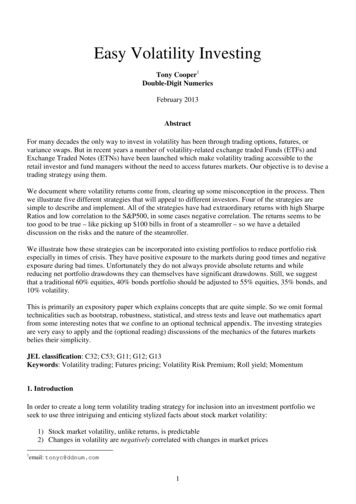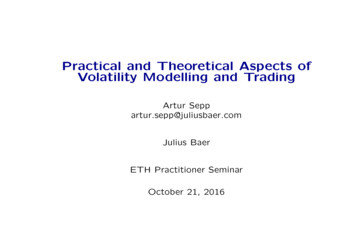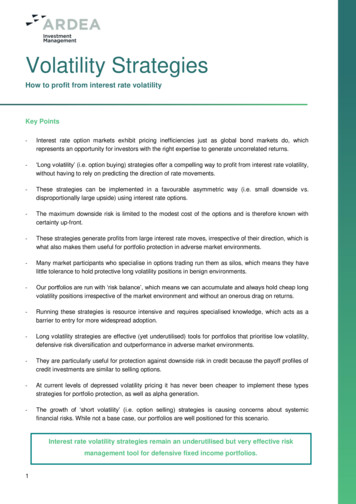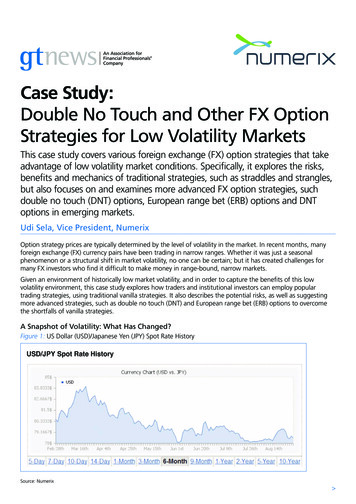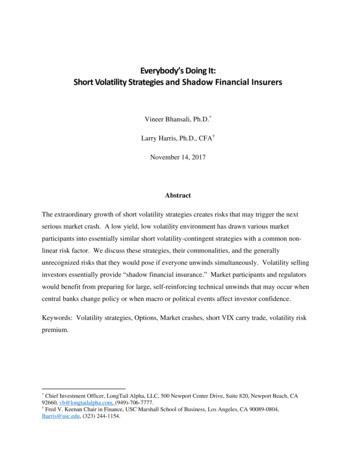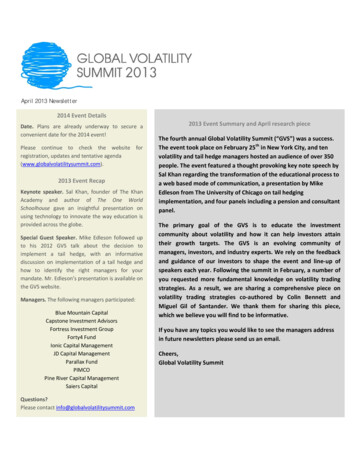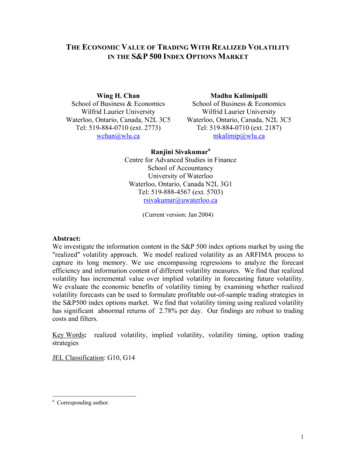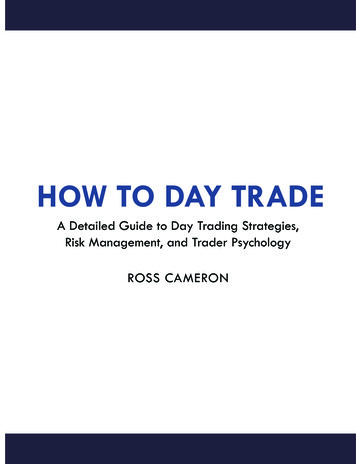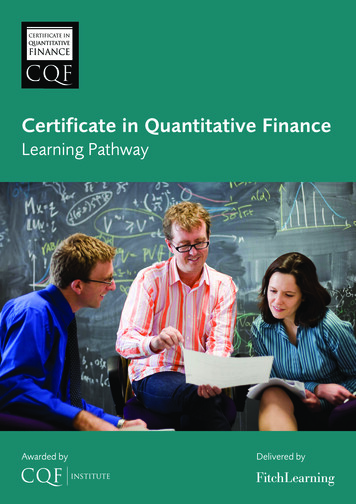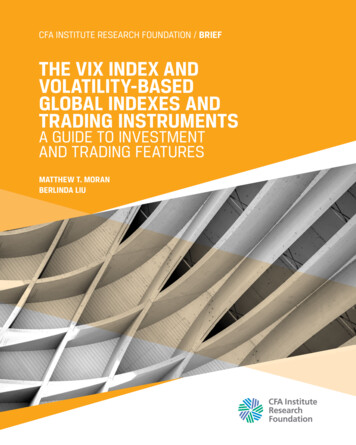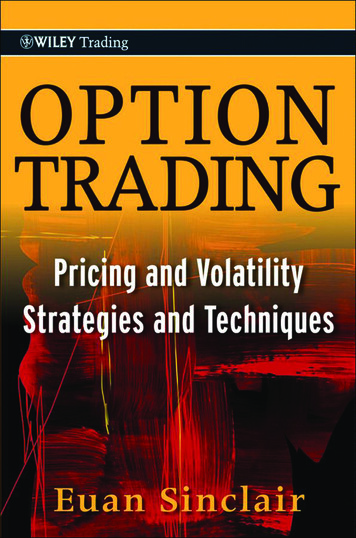
Transcription
P1: JYSindJWBT294-SinclairMay 7, 201017:11300Printer: Courier Westford, Westford, MA
P1: JYSfmJWBT294-SinclairApril 21, 201013:33Printer: Courier Westford, Westford, MAOptionTradingi
P1: JYSfmJWBT294-SinclairApril 21, 201013:33Printer: Courier Westford, Westford, MAFounded in 1807, John Wiley & Sons is the oldest independent publishing company in the United States. With offices in North America, Europe,Australia, and Asia, Wiley is globally committed to developing and marketing print and electronic products and services for our customers’ professional and personal knowledge and understanding.The Wiley Trading series features books by traders who have survivedthe market’s ever-changing temperament and have prospered—some byreinventing systems, others by getting back to basics. Whether a novicetrader, professional, or somewhere in-between, these books will providethe advice and strategies needed to prosper today and well into the future.For a list of available titles, visit our web site at www.WileyFinance.com.ii
P1: JYSfmJWBT294-SinclairApril 21, 201013:33Printer: Courier Westford, Westford, MAOptionTradingPricing and VolatilityStrategies and TechniquesEUAN SINCLAIRJohn Wiley & Sons, Inc.iii
P1: JYSfmJWBT294-SinclairApril 21, 201013:33Printer: Courier Westford, Westford, MAC 2010 by Euan Sinclair. All rights reserved.Copyright Published by John Wiley & Sons, Inc., Hoboken, New Jersey.Published simultaneously in Canada.No part of this publication may be reproduced, stored in a retrieval system, or transmitted inany form or by any means, electronic, mechanical, photocopying, recording, scanning, orotherwise, except as permitted under Section 107 or 108 of the 1976 United States CopyrightAct, without either the prior written permission of the Publisher, or authorization throughpayment of the appropriate per-copy fee to the Copyright Clearance Center, Inc., 222Rosewood Drive, Danvers, MA 01923, (978) 750-8400, fax (978) 646-8600, or on the Web atwww.copyright.com. Requests to the Publisher for permission should be addressed to thePermissions Department, John Wiley & Sons, Inc., 111 River Street, Hoboken, NJ 07030, (201)748-6011, fax (201) 748-6008, or online at http://www.wiley.com/go/permissions.Limit of Liability/Disclaimer of Warranty: While the publisher and author have used their bestefforts in preparing this book, they make no representations or warranties with respect to theaccuracy or completeness of the contents of this book and specifically disclaim any impliedwarranties of merchantability or fitness for a particular purpose. No warranty may be createdor extended by sales representatives or written sales materials. The advice and strategiescontained herein may not be suitable for your situation. You should consult with aprofessional where appropriate. Neither the publisher nor author shall be liable for any loss ofprofit or any other commercial damages, including but not limited to special, incidental,consequential, or other damages.For general information on our other products and services or for technical support, pleasecontact our Customer Care Department within the United States at (800) 762-2974, outside theUnited States at (317) 572-3993, or fax (317) 572-4002.Wiley also publishes its books in a variety of electronic formats. Some content that appears inprint may not be available in electronic books. For more information about Wiley products,visit our web site at www.wiley.com.Library of Congress Cataloging-in-Publication Data:Sinclair, Euan, 1969Option trading : pricing and volatility strategies and techniques / Euan Sinclair.p. cm. – (Wiley trading series)Includes index.ISBN 978-0-470-49710-4 (cloth)1. Options (Finance) 2. Pricing–Mathematical models. I. Title.HG6024.A3S5622 2010332.63’2283–dc222010003139Printed in the United States of America10987654321iv
P1: JYSfmJWBT294-SinclairApril 21, 201013:33Printer: Courier Westford, Westford, MATo my parentsv
P1: JYSfmJWBT294-SinclairApril 21, 201013:33viPrinter: Courier Westford, Westford, MA
P1: JYSfmJWBT294-SinclairApril 21, 201013:33Printer: Courier Westford, Westford, MAContentsPrefacexiProfessional TradingxiiThe Role of MathematicsxivThe Structure of this BookxviAcknowledgmentsxixCHAPTER 1HistorySummaryCHAPTER 216Introduction to Options7Options9Specifications for an Option Contract9Uses of Options11Market Structure14Summary20CHAPTER 3Arbitrage Bounds for Option Prices21American Options Compared to European Options25Absolute Maximum and Minimum Values25Summary39CHAPTER 4Pricing Models41General Modeling Principles42Choice of Dependent Variables45vii
P1: JYSfmJWBT294-SinclairApril 21, 201013:33Printer: Courier Westford, Westford, MACONTENTSviiiThe Binomial Model48The Black-Scholes-Merton (BSM) Model55Summary61CHAPTER 5The Solution of theBlack-Scholes-Merton(BSM) TER 6Option StrategiesForecasting and Strategy SelectionThe Strategies8993SummaryCHAPTER 789116Volatility Estimation117Defining and Measuring Volatility119Forecasting Volatility129Volatility in Context132Summary136CHAPTER 8Implied VolatilityThe Implied Volatility Curve137138Parameterizing and Measuring the ImpliedVolatility Curve142The Implied Volatility Curve as a Functionof Expiration145Implied Volatility Dynamics146Summary151
P1: JYSfmJWBT294-SinclairApril 21, 201013:33Printer: Courier Westford, Westford, MAContentsCHAPTER 9ixGeneral Principles of Tradingand Hedging153Edge154Hedging156Trade Sizing and Leverage158Scalability and Breadth163Summary164CHAPTER 10 Market Making Techniques165Market Structure166Market Making169Trading Based on Order-Book Information181Summary189CHAPTER 11 Volatility Trading191Hedging192Hedging in Practice193The P/L Distribution of Hedged Option Positions203Summary213CHAPTER 12 Expiration Trading215Pinning215Pin Risk219Forward Risk221Exercising the Wrong Options221Irrelevance of the Greeks223Expiring at a Short Strike224Summary225CHAPTER 13 Risk Management227Example of Position Repair228Inventory232Delta234
P1: JYSfmJWBT294-SinclairApril 21, 201013:33Printer: Courier Westford, Westford, k Risk: Dividends and Buy-in Risk242The Early Exercise of Options243Summary248Conclusion249APPENDIX ADistributions253Example253Moments and the “Shape” of Distributions254APPENDIX B263CorrelationGlossary271Index285
P1: JYSfmJWBT294-SinclairApril 21, 201013:33Printer: Courier Westford, Westford, MAPrefaceraders tend to be a pragmatic group. They are largely interested inresults. Actually some become so focused on results that it becomesa hindrance. This tendency can be a handicap, as the way to achievegood results is to focus on good processes and let the results take care ofthemselves. Good traders learn this.But good traders are still intellectually parsimonious. They want toknow what works, but seldom more than the minimum they need. WhenI’m feeling uncharitable I regard this as characteristic of the uncurious,dull people I have had the misfortune to work with, and indeed some werelike this. More realistically, however, this is less a reflection on the tradersthemselves, most of who were intelligent people with a wide range of interests, and more a reflection on the nature of trading.Trading is complex, changeable, and potentially emotionally draining.Once a trader has learned a sensible, statistically valid, profitable method,he is better off concentrating on exploiting it rather than continuing toexperiment.So a perfectly valid question when told something is “Why do I needto know this?” As a general answer, in the case where everything else isequal, the trader with more knowledge will make more money. He will alsobe more easily able to adapt to new markets and opportunities.It is possible to trade options successfully without knowing aboutthe Black-Scholes-Merton model, or any other pricing model. But for thetraders who do this, everything is a special situation. They have to individually learn every nuance with no organizing principle. It would be liketrying to learn chemistry without knowing about the periodic table. BlackScholes-Merton provides a simplifying framework. Traders who know thiscan then learn other things more easily, because they use less energy remembering the otherwise unconnected facts.Throughout this book I will tell you things that are truly useful and notmerely “interesting.” Trading is interesting only if it is profitable.However I have no interest in, or intention of, making this an easy readfor the “average person.” The reason for this is that the “average person”Txi
P1: JYSfmJWBT294-SinclairApril 21, 201013:33Printer: Courier Westford, Westford, MAPREFACExiiwill not succeed as a trader, so I would be making things more difficultfor myself by oversimplifying. The text would be longer and more boring.Trading is hard and options are complicated. Much of this book will requirework and thought. It is not meant to be a light read; it is meant to be athorough treatment.I want this book to be the only book an intelligent, diligent personwould need in order to go from knowing nothing about options to beingable to trade professionally at a legitimate trading operation (a bank, ahedge fund, or a market making firm).PROFESSIONAL TRADINGIt is commonly believed that 90 percent of those attempting to trade willlose money. This is a difficult number to verify. First, the people in possession of the data needed to prove this are members of brokerages andclearing firms, and they have no interest in publicizing the fact that the vastmajority of their customers fail. Second, we cannot learn much by interviewing traders as there is the problem of survivorship bias (the only people who will identify themselves as traders are those who have not gonebankrupt), and all people tend to exaggerate their successes and minimizetheir losses.But even if this figure is somewhat exaggerated, its implications arestartling. Most people will fail at trading. The normal excuses for this largescale failure rate given in trading books or seminars (when it is even acknowledged) take one of two forms.r Traders do not know the correct techniques, where “correct” corresponds to whatever the particular expert is trying to sell.r Traders do not have the psychological discipline needed to stick withtheir plan. This is laughable. I know of no other field of endeavor wherefailure to perform a skill is routinely blamed on psychology. Would youseriously listen to a basketball coach who told you that the main reason you were not in the NBA was your lack of discipline and desire?While great players are also psychologically strong, no amount of desire and resolve would turn me into a professional level player. Beingundisciplined might be a personal failing, but it is by no means the mostimportant one. This is also true in trading. Psychological coaching canhelp a winner, but it will not make a winner.Hundreds of books discuss these subjects, but the survival rate oftraders gets no better. Yet the proprietary trading desks of banks continue
P1: JYSfmJWBT294-SinclairPrefaceApril 21, 201013:33Printer: Courier Westford, Westford, MAxiiito be profitable (even in the carnage of 2008) and hedge funds proliferate.Why can professionals consistently do what the amateurs cannot? Why arethe same groups successful year after year? In many fields the answer tothis question is obvious: it is because they are better. For example, a professional basketball player is doing what I do, but he does it much better.Trading is different. Professionals do not generally have more knowledge,more skill, or more psychological mastery. They make money because theyare playing a totally different game.Many people completely fail to see this. They are encouraged in thisview by the proliferation of financial news media. There are several fulltime business television channels, daily newspapers, business radio stations, and various Web services that offer to bring people the “inside” viewof the markets. They do not. If anything, they give their consumers a falsesense of the depth of their knowledge. Particularly misleading are the occasions when a floor trader is interviewed and asked for his views on aparticular market. The answer will invariably sound useful, containing ananalysis of the market’s technical and fundamental factors. But successful traders do not care about these things and asking a floor trader for hisopinion on them is like asking Tiger Woods for tennis lessons. He is a greatsportsman and he hits a ball with an implement, but his tennis views andopinions are no more likely to be valid than those of most other people.Knowledge is still crucial, but for derivatives traders it is not technical analysis or fundamental analysis that is important. They need a soundknowledge of market structure and arbitrage relationships. The way theyconsistently make money is through arbitrage and its weaker relatives:quasi-arbitrage, statistical arbitrage, and structural arbitrage.We will be talking a lot about winning and losing. These can be emotionally loaded terms. No one likes to be called a loser, and, particularly ifyou are under the age of 40, you have probably become accustomed to having your self-esteem boosted to the point where you think that even if youlose money you still are not a loser. This is the wrong way to think. That isexactly what you are and if you want that unpleasant fact to change, youfirst need to accept it.Being a loser does not make you a bad person. On the contrary, manyof the things winners do would make them bad people in any normalsetting. Winners (while not setting out to be deliberately unpleasant) arefiercely competitive, obsessive and often morose and cranky while trading.We do not trade to make friends; we trade to make money.There is a common misconception of the successful trader as existing in a state of preternatural calm. Of course this would be nice, but onecannot sustain this state while at the same time maintaining the necessarylevel of obsession. Edges are so small, that you must be a complete controlfreak. You need to obsess over every detail.
P1: JYSfmJWBT294-SinclairApril 21, 201013:33Printer: Courier Westford, Westford, MAxivPREFACEAll of this may sound very negative. It could be construed that way. Onthe other hand, I’m going to give you a path that has a far greater chanceof success. In contrast to the 90 percent failure rate cited earlier, over50 percent of the people I have ever known in this industry are still in it,meaning that they are competent professionals. Those who succeed are notdistinguished by special intelligence. They have learned to put themselvesin market niches that give them an edge. This is the most important tradingdecision they have made. If you also do this and are not stupid, lazy, ordishonest, you can also succeed.Trading success is measured in money, but people who are purely motivated by money might want to reconsider trading as a career choice.We’ve already pointed out the colossal failure rate. But even traders who“succeed” may not make great fortunes. Many traders manage to stay inthe game without accumulating great wealth. Most of these people couldprobably have achieved about the same income in another job. Further, amore conventional career choice would follow a standard path of professional development. A lawyer with 20 years of experience might be a partner in a law firm or a judge. A trader does not have these opportunities.If he wants to keep trading he will be in the same job as he was when hestarted.So why trade? The reason to become a trader is the same reason someone should choose any career: Because that is what they do and who theyare. Eventually this consideration overwhelms all others. As G. H. Hardysaid in, “A Mathematician’s Apology,” “I do what I do because it is the oneand only thing that I can do at all well. . . . If a man has any genuine talenthe should be ready to make almost any sacrifice in order to cultivate it tothe full.”THE ROLE OF MATHEMATICSA (very annoying) colleague once asked for something to read about option trading that “was not mathematical.” This really is not possible. Allof the concepts behind the structure, pricing, and trading of options areinherently mathematical. This is true of all trading.Nonetheless there is a large group of traders who vociferously statetheir distrust of mathematics. The most charitable thing I can say aboutthese people is that they really are not thinking about what they are saying.Do they really doubt that a trader who makes a million dollars a year isbetter than one who loses a million dollars? After all, this is a question thatcan be decided only by using the appropriate mathematics. This case is simple. Is A greater than B? But just because a situation is less clear-cut does
P1: JYSfmJWBT294-SinclairPrefaceApril 21, 201013:33Printer: Courier Westford, Westford, MAxvnot necessarily make the application of mathematics irrelevant. In fact, Ihope to show that more complex situations need the most mathematicalanalysis.I do not claim that everything is about mathematics. Intangibles matter.Leadership, inspiration, grit, and heart are all important. But they matteronly if they lead to something tangible. And results are always tangible.Causes may not be.A skilled mathematical trader will use math and statistics to simplifythe world. A good mathematical model takes a very complex situation andmakes it possible to identify a cause and an effect. All traders do this. “Ifnonfarm payroll comes in under expectations, the market will rally,” is anexample of a trader using a model in this way. He has not expressed it in anequation, but it is the same process. Someone can choose to simplify theworld in a different way to you. This is not a problem. It is a good thing.You can always learn from divergent viewpoints.A good model has to be based on the appropriate selection of inputs.To predict the score of a baseball game, for example, we might considerthe number and type of hits each team averages, how often players takewalks and how many runs the pitching staffs give up. Our predictive modelwill then be some function of these variables. But if we were to also includethe population of each team’s home city, then our prediction would clearlyrest on an unstable foundation. Fundamental knowledge is necessary toavoid this situation.So I need to assume a certain amount of mathematical literacy, andit is not immediately obvious where to draw this line. I’ve basically decided to assume that someone who wants to be a serious option tradershould have picked up the mathematics of a good high school education.This includes algebra, logarithms, and exponentiation and basic calculus.The Black-Scholes-Merton (BSM) formalism requires more complex mathematics to do properly. We avoid this by doing it improperly. I think wecan get the essential points across this way. An option trader need not beable to give a rigorous derivation of this equation (those who first did sowere rewarded with Nobel prizes), but should be able to follow an informaldiscussion of it.I make an exception for statistics. Here I assume that you know farless, and discuss probability distributions, descriptive statistics, inference,and sampling. There are two reasons for this. First, I’ve found that manypeople come into finance with a strong background in mathematics or thephysical sciences. To these people calculus is simple, but their groundingin statistics is generally weak. Second, many successful traders have hadonly a basic understanding of the mathematics behind BSM and certainlyhave no idea of the differences between calculus and stochastic calculus.
P1: JYSfmJWBT294-SinclairApril 21, 201013:33Printer: Courier Westford, Westford, MAxviPREFACEThis is not generally a great problem. But misunderstanding statistics andprobability can, and does, lead to disastrous decisions.THE STRUCTURE OF THIS BOOKThis book is roughly divided into three parts. First we will introduce options, both historically and conceptually. Next we use the no-arbitrage principle to introduce option pricing. We examine both static arbitrage relationships and the dynamic hedging approach. The last, and largest, part of thebook is about how to actually trade options.In Chapter 1 we discuss the history of options and other financialderivatives. I think these stories are interesting, but even if they were notinteresting, they would be important. Sadly, option traders will often findthemselves in situations where they need to defend their profession. Thiscan happen in social situations, which is annoying, but it is also a topic ofpolitical debate. Traders cannot reasonably expect much public sympathy,but they need to be able to conduct a coherent defense of the morality,necessity and desirability of the existence of their business. Understanding the history of derivatives and particularly the way that they have beenblamed for many past financial catastrophes can only help do this.Chapter 2 introduces options and option markets. While this is undoubtedly boring material, it is probably the most important chapter in thebook. Unless the reader has a solid grasp of basic definitions and nomenclature, he will not be able to go any further.Chapter 3 is the first chapter in the pricing section of the book. Weintroduce the concept of no arbitrage and use it to derive relationships between call and puts and options of different strikes and maturities. Again,many of the proofs here are tedious, but the results must become secondnature and good traders will become familiar enough with the principle ofno arbitrage to be able to apply it to the analysis of unfamiliar structuredproducts.In Chapter 4 we work through the two most important option pricing models: the binomial tree and the Black-Scholes-Merton (BSM) model.These are not the most important models because they are the most useful. Neither one is actually used in practice much anymore. However, theyprovide the conceptual basis for most other models, and traders need tobecome familiar with their assumptions and how we compensate for thesein practice.Chapter 5 examines the solution to the BSM model and introducesthe famous greeks, the sensitivities of the option price to various parameters and variables. Although the equations we give are tied to the BSM
P1: JYSfmJWBT294-SinclairPrefaceApril 21, 201013:33Printer: Courier Westford, Westford, MAxviiformalism, the nature of the greeks is not. The behavior of the greeks ismore fundamental than this. Options really do have these dependenciesirrespective of the particular pricing model we use. This is important: wewant to become familiar with options, not with option pricing models.By this point we will know what options are, and how they are priced.Next we can learn how to trade them. Chapter 6 looks at the various strategies that can be constructed from simple calls and puts. Many books dothis, but most do so from the perspective of a customer who is trying toconstruct a directional bet with certain risk characteristics. As professionaltraders, we generally will not be doing this. We will usually be interested inthe volatility aspects of a given position. Nonetheless we still need to knowwhat the standard positions and strategies are.Option pricing models are not magic. They are incredibly helpful trading tools, but they still need inputs in order to generate option prices. Themost important of these is volatility. Chapter 7 shows how to measure andforecast volatility. Chapter 8 is somewhat complementary. Here we consider the nature and behavior of implied volatility: the volatility that theoption market is using at any point. The interplay between implied volatility and realized volatility is central to the theory and practice of optiontrading.While trading does involve instinctual actions it also has a number ofaspects that can be quantified. There are a number of indisputable mathematical truths that need to form the basis of any sensible trading operation.In Chapter 9 we introduce the concept of expected value, the general ideaof hedging and the idea of trade sizing: looking at a trade as a part of acontinuing business plan rather than a single unrepeated bet.Chapter 10 discusses the basic ideas and strategies of market making.Not all option traders will be market makers, but all traders can benefitfrom understanding their behavior. At the very least this will improve atrader’s ability to execute trades.In Chapter 11 we examine volatility trading, in particular, how to hedgeand what to expect when we do. Volatility trading is a viable stand-alonestrategy, but it also needs to be understood by any trader using options.Option traders inevitably take positions in volatility even if this is not theirprincipal focus.Expiry trading gets a separate chapter: Chapter 12. Nothing about expiration is really fundamentally different from any other time, but everything that happens is far more extreme. It provides opportunities for goodtrading, but also risks that are much larger than at other times. Risk management is the most important thing for an option trader to do. Everythinga trader does, and everything in this book, is about risk management. Alltrades must be evaluated by both their return and their risk. But there is another level of risk management to consider as well. At this level, we think
P1: JYSfmJWBT294-SinclairxviiiApril 21, 201013:33Printer: Courier Westford, Westford, MAPREFACEfar less about the probability of an event, and much more about the consequences of its occurrence. This is just one of the many inconsistencies thata trader must become comfortable with. We spend a lot of time estimatingprobabilities of events before we do a trade. But we also need to make surethat in no state of the world, no matter how unlikely, can the trade causeus to go broke. This type of analysis is covered in Chapter 13.
P1: JYSfmJWBT294-SinclairApril 21, 201013:33Printer: Courier Westford, Westford, MAAcknowledgmentsany people helped me with this project, but deserving of particular thanks are those who did proofreading. At the risk of forgetting someone, special thanks go to Julien Gosme, Rich Ghazarian,Nicolas Tabardel, Chetan Mehra, Christopher Merrill, DN, AlexanderChiang, David Rasho, Derek G. Nokes, Elizabeth S. Duquette, and BenjaminPortheault.I’d also like to thank all of the traders I have worked with. Some needto be thanked for the cautionary tales they provide and some for the valuable advice and education they gave me. Notable members of this secondgroup are Art Duquette, Don Perettie, David Little, and, in particular, RaoulRodriguez, who pointed out to me that “if you shut up and listen you mightnot be in that clerk’s jacket forever.”Mxix
P1: JYSfmJWBT294-SinclairApril 21, 201013:33xxPrinter: Courier Westford, Westford, MA
P1: OTAc01JWBT294-SinclairMay 5, 20107:12Printer: Courier Westford, Westford, MACHAPTER 1HistoryIn our view, however, derivatives are financialweapons of mass destruction, carrying dangers that,while now latent, are potentially lethal.—Warren Buffett, letter to shareholders, 2002erivatives have often been characterized as dangerous tools of financial speculation, invented by mathematicians who are out oftouch with reality, then sold by unscrupulous salesmen to gulliblecustomers who do not understand the risks they are taking. They havebeen blamed for most periods of modern financial turmoil, including the1987 crash, the bankruptcy of Barings Bank, the meltdown of Long TermCapital Management, and the current “subprime crisis.” Like many populist misconceptions, there are germs of truth in this straw man, but thefull truth is far more nuanced, complex, interesting, and profitable to thosewho understand.Derivatives are as old as recorded history. The first reference we haveto derivatives is in Genesis 29. Jacob entered an agreement that obligatedhim to work for seven years in exchange for the hand of Rachel. However,after Jacob had fulfilled his part of the contract, Rachel’s father, Laban, defaulted on his obligations and made Jacob instead marry his elder daughter,Leah. So Jacob entered another agreement in which he again worked forseven years in order to marry Rachel.Dr This was a forward agreement where Jacob paid (in labor) in returnfor something (Rachel) to be delivered at a certain time in the future(seven years).1
P1: OTAc01JWBT294-Sinclair2May 5, 20107:12Printer: Courier Westford, Westford, MAOPTION TRADINGr Laban defaulted, by not carrying out his obligations under the contract,making this not only the first derivative we know of but also the firstdefault.r Jacob may not have been a great trader. He entered a contract at a highprice, was cheated, and then did the same thing again.The first unambiguously historical reference to options is in “The Politics” by Aristotle. He tells the story of the philosopher Thales of Miletuswho lived from 624 to 527 B . C. It seems that Thales eventually grew tired ofhearing variants of the question, “If you are so smart why aren’t you rich?”and resolved to show that learning could indeed lead to riches. Accordingto Aristotle:He, deducing from his knowledge of stars that there would be a goodcrop of olives, while it was still winter raised a little capital and usedit to pay deposits on all the oil-presses in Miletus and Chios, thussecuring an option on their hire. This cost him only a small sum asthere were no other bidders. Then the time of the harvest came andas there was a sudden and simultaneous demand for oil-presses, hehired them out at any price he liked to ask.Thales actually bought a call option. The deposits bought him the right,but not the obligation, to hire the presses. If the harvest had been poor,Thales would have chosen not to exercise his right to rent the presses andlost only the initial deposit, the option premium.
Option trading : pricing and volatility strategies and techniques / Euan Sinclair. p. cm. – (Wiley trading series) Includes index. ISBN 978-0-470-49710-4 (cloth) 1. Options (Finance) 2. Pricing–Mathematical models. I. Title. HG6024.A3S5622 2010 332.63’2283–dc22 20100031
